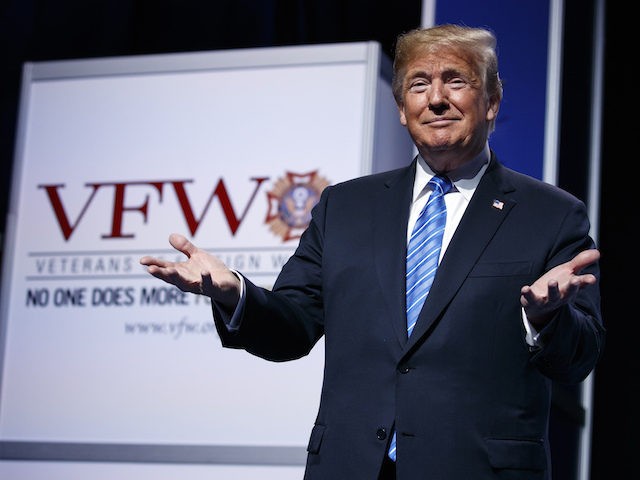Establishment trade economists appear to be united in both their contempt for Donald Trump’s tariffs and their ignorance that it is rooted in standard trade theory.
A consistent theme of Trump’s statements about trade has been that the United States has made bad trade deals in the past and that our trading partners have rationally taken advantage of the “stupidity” of our leaders. He’s often said he isn’t angry about what the other nations did because they were just doing what was in their interest.
“Tariffs are the greatest!” Trump declared this week, which surely sent shivers of disdain down the backs of many trade economists. But in the same tweet he offered an explanation of that statement that is well-supported by standard trade theory.
“Either a country which has treated the United States unfairly on Trade negotiates a fair deal, or it gets hit with Tariffs. It’s as simple as that — and everybody’s talking! Remember, we are the ‘piggy bank’ that’s being robbed. All will be Great,” Trump said.
First, notice what Trump is not doing. Import tariffs are often characterized as taxes imposed on imported goods that would harm consumers and are usually enacted to protect a country’s domestic producers, often to protect domestic monopolies exercising powerful political influence. These tariffs can serve only to redistribute wealth or, worse, can reduce a nation’s wealth while lining the pockets of special interests. While this was true historically of many tariffs, this is not the system Trump is defending.
Trump’s statements reflect a different idea of tariffs, one that has a long pedigree but was introduced into modern economics in 1940 by British economist Nicholas Kaldor. It goes by the name “optimal tariff theory.” The idea is that for any large, wealthy country, a tariff can be used to increase national wealth rather than just protect domestic producers.
Kaldor’s idea is that a large, wealthy nation can have market power akin to a monopolist over the price of the goods it exports and the goods it imports. When it erects a tariff barrier, it can improve its terms of trade because it lowers demand for the imports—thereby lowering their prices on the global market prices—while raising demand for domestically produced goods—raising the price of its exports to the rest of the world. Setting a tariff that is not too high or too low—the optimal tariff—therefore increases national wealth.
It is more or less clear that this is the model Trump has in mind when he talks about trade. He clearly believes that countries can offset the costs of reduced imports – the higher cost of producing goods domestically that could be more cheaply made abroad – with gains from improved terms of trade.
Kaldor pointed out that the optimal tariff depended on three things. First, the tariff could not be too large—it probably has to be smaller than required to “protect” domestic monopolists. Second, the country has to be large enough to have something akin monopolistic power on global markets. Third, other countries would not retaliate.
It’s that third condition that has led most standard trade theorists to believe that imposing an optimal tariff is not a realistic policy because obviously other countries would retaliate. And that’s how you start a trade war in which each country tries to impose optimal tarrifs but only ends up with the costs of reduced trade—higher consumer costs—without the benefits of improved terms of trade.
When trade economists like Paul Krugman attempt to spy some rationality in what Trump is doing they often see it in these terms. It looks to them like Trump is setting off something like “optimal tariff warfare” that will make everyone worse off.
Imagine, however, that a country knew its major trading partner would not retaliate with tariffs. Perhaps its government is dominated by import-shipping interests. Perhaps by free-trade ideologues. Perhaps by financiers who profit by providing trade finance to importers and debt and equity financing to domestic businesses sapped for capital by declining income. Perhaps the government thinks its non-economic geo-strategic goals are worth the cost created by non-retaliation.
In that situation, the case for erecting an optimal tariff is revived under the Kaldor model. Absent retaliation, countries could improve their national wealth by imposing tariffs and other trade barriers. The free-trading nation would basically be handing them the opportunity to prosper at its expense.
This is the situation Trump believes we have been in for several decades. We’ve lowered our trade barriers and tariffs far more than our trading partners and largely over-looked theirs—sometimes complaining, even loudly, but seldom taking serious action. And this has more or less invited the rest of the world to build up their optimal tariff walls.
So what can be done to get us to a free-trade equilibrium instead of the current asymetrical optimal tariff situation? The free-trade nation has to become a credible tariff threat. It has to convince the rest of the world that it will no longer be the “sucker nation” sacrificing its own wealth for their benefit.
In other words, it needs to convince its trading partners that it believes “Tariffs are the Greatest” while still holding out the possibility that it will not impose tariffs if other countries take down their Optimal Tariffs. That notion of trade “reciprocity” has been the very consistent message of Trump and his advisers.
Far from being some extraordinary deviation from standard trade theory, Trump’s trade policies appear to be grounded in Kaldor’s and subsequent economists work on optimal tariffs. And that theory tells us that what reduces optimal tariffs is a credible threat of retaliation—exactly what Trump is creating.

COMMENTS
Please let us know if you're having issues with commenting.